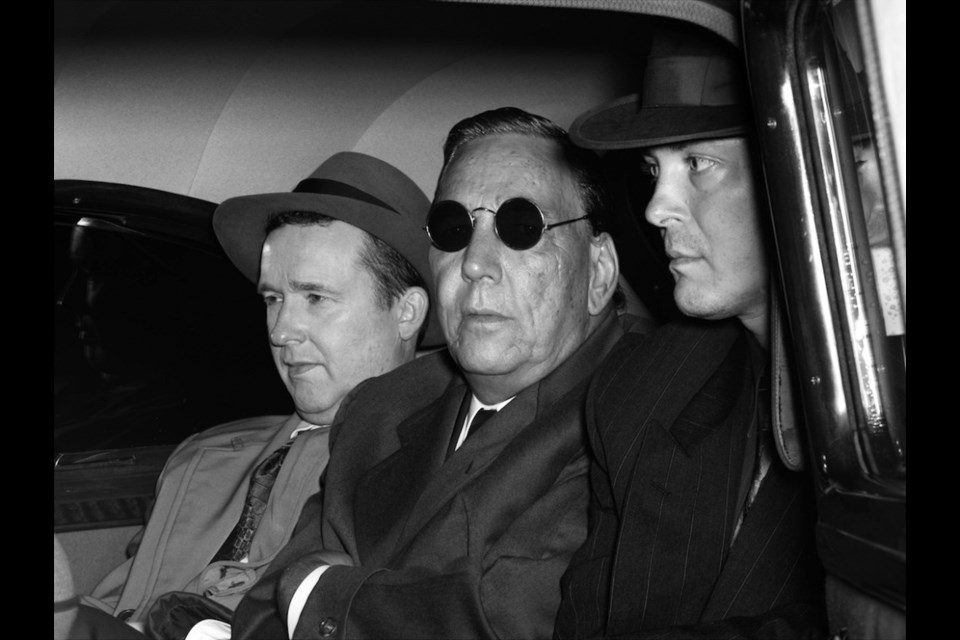Film noir is a kingdom of corruption.
There are cops on the take and dames who’ll take all they’ve got. There are box men, wheel men, fall guys, bar flies, stool pigeons, grifters, drifters, thugs, lugs, pugs and reporters.
That world of rainslicked city streets and lonely figures smoking cigarettes under lampposts is recalled in Stan Douglas: Synthetic Pictures.
The exhibition, currently showing at Presentation House Gallery in North Vancouver, includes a series of black and white photographs that tie to Vancouver’s own seedy history.
The most jaw dropping of Douglas’s works is Hogan’s Alley.
The photo illustration gives the viewer a big, black-and-white look at ramshackle shelters and small houses. You can see details like rotten boards and the way the light spills out of a window and onto the rust eating away at a corrugated tin roof.
But there’s something else about the picture.
Looking about the gallery, exhibit curator Helga Pakasaar hesitates to describe it.
“It’s truly realistic,” she says. “And yet...” She doesn’t finish her thought, as though the picture has some quality that lies beyond description.
The work was inspired by photos of the mixed race neighbourhood that was destined for destruction in 1972 to make way for the Georgia Viaduct.
The perspective is both wide and deep. Pakasaar compares the viewer’s vantage point to what a movie director can see from atop a crane. “It’s like you’re going to swoop into something,” she says.
The photo realism and depth of perspective is startling. “He could never have captured that in a photograph. The lens limits what it sees, this is lensless,” Pakasaar says.
The history of film noir is littered with bits of concrete poetry like: “He hasn’t got enough blood left in him to keep a chicken alive,” or “I’d hate to take a bite out of you. You’re a cookie full of arsenic.” But aside from pulp fiction and chiaroscuro lighting, the genre may owe its greatest debt to Weegee.
Also known as Arthur Fellig, Weegee was a freelance photographer who worked the graveyard shift, using flash bulbs to illuminate New York’s night in the 1930s, ’40s and ’50s.
With a darkroom in his trunk and a police radio by the dashboard, Weegee caught violence and death in 1/200th of a second.
Those crime photos are also recalled in Douglas’s collection.
“Suspect” shows one man flanked by what we assume are two overworked detectives. The camera’s flash casts each dent and divot in their faces in stark relief. With his arms crossed, the suspect seems to be staring right at you, but his eyes are hidden behind sunglasses.
“Intrigue” is a pair of women’s shoes reflected in a flawless background, almost like they were sitting on a lake of oil. “Burlap” appears to show a body beneath a cover, but when you look a little closer, you begin to notice the proportions of the background don’t make sense.
“It unravels into something kind of curious or mysterious,” Pakasaar says.
One of Douglas’s most striking pictures is Cache.
A square section of wall has been taken off, and inside we can see a pile of goodies including cash, cards, dominoes, dice, poker chips and London Dry Gin.
There’s a single hand in the frame holding one-third of a cigar and pointing at the cheap treasures with a stubby index finger.
Pakasaar suggests the picture may have been inspired by the lore of the Penthouse. In Courier contributor Aaron Chapman’s book Liquor, Lust, and the Law: The Story of Vancouver’s Legendary Penthouse Nightclub, heir to the VIP room Danny Filippone recounts finding a similar hidden spot. Fittingly enough, that cache was a pile of classic pictures.
Stan Douglas: Synthetic Pictures runs until May 25 at Presentation House Gallery. Details at presentationhousegallery.org.
jshepherd@nsnews.com


